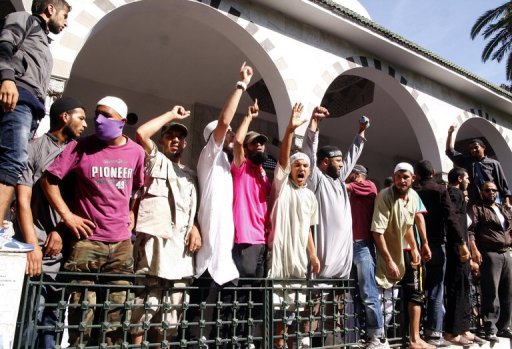Tunisia Feature: The Truth About the "Salafi Fanatics" (Marks)
Salafists demonstrate outside the El-Fath mosque in Tunis, 17 September 2012 (Photo: Salah Habibi/AFP)
Monica Marks writes for Foreign Policy:
Recent protests at the U.S. embassy in Tunis and corresponding attacks on the nearby American Cooperative School have cast sharp light on the Salafis allegedly responsible. Media accounts quickly dismissed the protesters as "Salafi fanatics," though some resembled rioting football fans more than religiously garbed ruffians.
Local journalists covering previous instances of Salafi-oriented unrest --- from the October 2011 demonstrations against the film Persepolis to this June's riots at an art exhibit in Tunis's upscale La Marsa district -- have tended to narrate events from afar without directly interviewing Salafis. Such slipshod coverage has tended to leave readers with a broad-brush portrait of Tunisian Salafism --- one that obscures important details concerning the movement's composition and complexity. Far from being a monolithic group of highly organized extremists, Tunisia's Salafis are in fact a loose collection of religiously right-wing individuals whose identities and motivations require far closer scrutiny.
The emergence of "Salafism" as a political category is itself a very recent development in Tunisia. Before the January 2011 revolution, Tunisia's Salafis seemed virtually invisible and almost entirely apolitical. During the 1990s and, to a lesser extent, the 2000s, both moderate and militant Islamists were imprisoned, forced underground, or driven into exile. Like leftists, insubordinate trade unionists, provocative bloggers, and a whole host of perceived regime opponents, Islamists -- who sought to engage in faith-based forms of political activism -- were systematically silenced. Former President Zine El Abidine Ben Ali likely allowed a small window of space for ultra-right wing activities, largely as an effort to justify his rule as a necessary bulwark against terrorism during the 2000s. For the most part, however, Islamists --- both mainstream moderates and potentially militant right-wingers --- spent the better part of the 1990s and 2000s simply trying to fly under the regime's radar and avoid arrest.
Following the revolution, Tunisia's long-muzzled media establishment --- which had little experience in meaningfully critiquing social or political developments --- struggled to make sense of the upsurge in conservative forms of religious dress, such as long beards and full face veils. Last summer, many secularly inclined Tunisians described Ennahda and the Salafis as practically synonymous. This year, as Salafi styles of conservative dress and religiously oriented protests have become increasingly commonplace, media outlets have begun devoting more attention to unpicking the divisions between the two groups. Though many secular opponents of Ennahda still believe the two movements are interchangeable, Tunisian press coverage now generally portrays Salafis as ultra-conservative, violently natured persons whose sympathies lay to the right of Ennahda. Ennahda has sought to encourage that interpretation, repeatedly characterizing itself as a centrist movement caught between Salafi and secularist extremes.
The distinction between Tunisian Salafism and mainstream Islamist politics is an important one, and represents a step toward better understanding the dynamics of intra-Islamist competition in Tunisia. While the most liberal strain of Salafism overlaps with the most right-wing strain of Ennahda, the two movements are distinct and often at loggerheads.
Simply positioning "Salafis" as a broad group of radicals who may challenge Ennahda from the right, however, fails to sufficiently explain the nature of Salafi activism in Tunisia. Tunisian press and political commentators ontinue to regularly employ the term "Salafism" as a convenient by-word for "bearded youths whose rage we don't understand." The term "Salafism" has, in fact, become a convenient conceptual dumping ground, a kind of catchall waste bin into which journalists and some academics have tended to blithely toss individuals and actions that seem aggressive or incomprehensible. Like "Islamism," a term that has been used to link actors as disparate as Osama bin Laden and Oxford professor Tariq Ramadan, the word "Salafism" often confuses more than it clarifies.

 Monday, October 1, 2012 at 8:49
Monday, October 1, 2012 at 8:49
Reader Comments